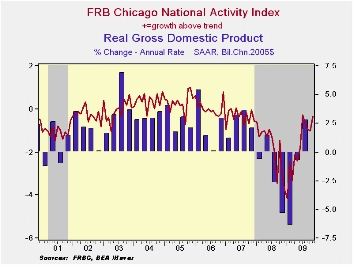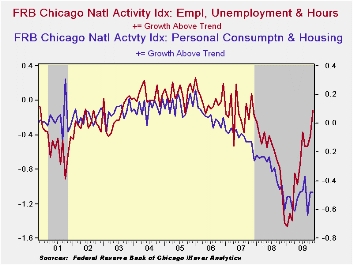 Global| Dec 21 2009
Global| Dec 21 2009Chicago Fed Index Recovered Recent Declines To Best In Two Years
by:Tom Moeller
|in:Economy in Brief
Summary
The U.S. economy seems to be regaining forward momentum. That is the indication from the Chicago Fed National Activity Index (CFNAI) from the Federal Reserve Bank of Chicago. The index improved during November to a reading of -0.32. [...]
 The
U.S. economy seems to be regaining forward momentum. That is the
indication from the Chicago Fed National Activity Index (CFNAI) from
the Federal Reserve Bank of Chicago. The index improved during November
to a reading of -0.32. That gained back the declines during the prior
three months and pulled the index level to its highest since November
2007, up from the series' low of -4.13 reached this past January. Since
1970 there has been a 74% correlation between the level of the index
and the q/q change in real GDP but during the last ten years that
correlation has risen to 80%.
The
U.S. economy seems to be regaining forward momentum. That is the
indication from the Chicago Fed National Activity Index (CFNAI) from
the Federal Reserve Bank of Chicago. The index improved during November
to a reading of -0.32. That gained back the declines during the prior
three months and pulled the index level to its highest since November
2007, up from the series' low of -4.13 reached this past January. Since
1970 there has been a 74% correlation between the level of the index
and the q/q change in real GDP but during the last ten years that
correlation has risen to 80%.
The three-month moving average which smoothes out some of the volatility of the index also improved to near its highest level since February of 2008.
 An index
level at or below -0.70 typically has indicated negative U.S. economic
growth. A zero value of the CFNAI indicates that the economy is
expanding at its historical trend rate of growth of roughly 3%. The
complete CFNAI report is available here.·
The Chicago Fed indicated that 36 of the series' individual indicators
made positive contributions to the November index while 49 made
negative contributions. The CFNAI is a weighted average of 85
indicators of economic activity. The indicators reflect activity in the
following categories: production & income, the labor market,
personal consumption & housing, manufacturing & trade
sales, and inventories & orders.
An index
level at or below -0.70 typically has indicated negative U.S. economic
growth. A zero value of the CFNAI indicates that the economy is
expanding at its historical trend rate of growth of roughly 3%. The
complete CFNAI report is available here.·
The Chicago Fed indicated that 36 of the series' individual indicators
made positive contributions to the November index while 49 made
negative contributions. The CFNAI is a weighted average of 85
indicators of economic activity. The indicators reflect activity in the
following categories: production & income, the labor market,
personal consumption & housing, manufacturing & trade
sales, and inventories & orders.
In a separate survey, the Chicago Fed indicated that its Midwest manufacturing index improved modestly during October to its highest level since the June low. Indicators for the auto, steel, machinery and resource sectors each improved. The Chicago Federal Reserve figures are available in Haver's SURVEYS database.
| Chicago Fed | November | October | September | November '08 | 2008 | 2007 | 2006 |
|---|---|---|---|---|---|---|---|
| CFNAI | -0.32 | -1.02 | -0.95 | -2.99 | -1.77 | -0.35 | 0.05 |
| 3-Month Moving Average | -0.77 | -0.87 | -0.61 | -2.63 | -- | -- | -- |
| Personal Consumption & Housing | -0.48 | -0.48 | -0.64 | -0.43 | -0.33 | -0.10 | 0.06 |
| Employment Unemployment & Hours | -0.12 | -0.42 | -0.53 | -1.06 | -0.62 | -0.15 | 0.01 |
| Production & Income | 0.35 | -0.09 | 0.19 | -0.95 | -0.55 | -0.05 | -0.01 |
| Sales, Inventories & Orders | -0.07 | -0.02 | 0.03 | -0.53 | -0.24 | -0.06 | -0.01 |
Tom Moeller
AuthorMore in Author Profile »Prior to joining Haver Analytics in 2000, Mr. Moeller worked as the Economist at Chancellor Capital Management from 1985 to 1999. There, he developed comprehensive economic forecasts and interpreted economic data for equity and fixed income portfolio managers. Also at Chancellor, Mr. Moeller worked as an equity analyst and was responsible for researching and rating companies in the economically sensitive automobile and housing industries for investment in Chancellor’s equity portfolio. Prior to joining Chancellor, Mr. Moeller was an Economist at Citibank from 1979 to 1984. He also analyzed pricing behavior in the metals industry for the Council on Wage and Price Stability in Washington, D.C. In 1999, Mr. Moeller received the award for most accurate forecast from the Forecasters' Club of New York. From 1990 to 1992 he was President of the New York Association for Business Economists. Mr. Moeller earned an M.B.A. in Finance from Fordham University, where he graduated in 1987. He holds a Bachelor of Arts in Economics from George Washington University.






